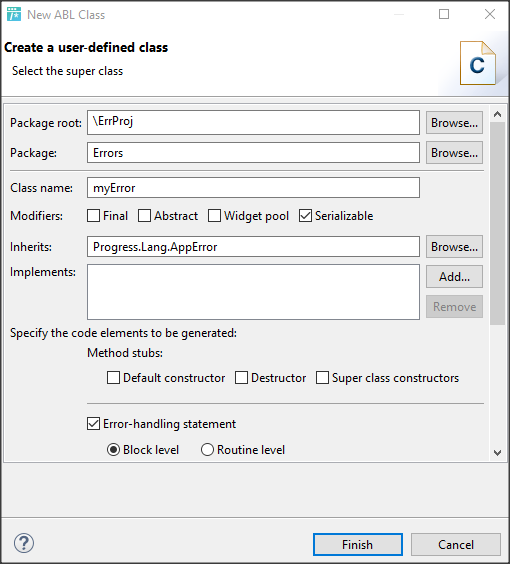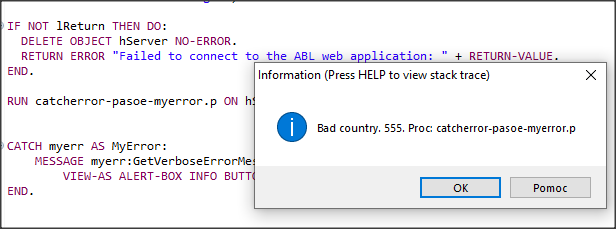
PASOE – OEMANAGER
Właśnie pojawiła się nowa wersja OpenEdge LTS 12.8 a wraz z nią sporo nowości. Poświęcę im cały artykuł, ale to następnym razem. Teraz chciałbym skupić się na jednym elemencie dotyczącym serwera aplikacji PASOE, a mianowicie na narzędziu OEMANAGER.
Pamiętacie może, że dla klasycznego appservera czy webspeeda można było uruchomić z poziomu wiersza poleceń (proenv) komendę ASBMAN czy WTBMAN aby uzyskać status procesu i podstawowe metryki.
Podobnie jest z OEMANAGER – można uzyskać wszystkie potrzebne metryki w jednym wywołaniu, w przeciwieństwie do innych sposobów jak wywołania API. Ponadto, narzędzie OEMANAGER może być wykorzystywane podczas runtime’u.
Aby można było z niego skorzystać instancja musi zawierać wdrożone aplikacje: OpenEdge Manager (oemanager.war) i Tomcat Manager (manager.war). Możemy wdrożyć je odpowienimi poleceniami do istniejącej instancji lub stworzyć nową z już wdrożonymi tymi aplikacjami używając opcji -f. Poniżej zamieszczam komendę utworzenia takiej instancji mypasoe. Do niedawna zalecani nie instalować tych aplikacji w środowisku produkcyjnym ale obecnie nie ma takich przeciwskazań o ile odpowienio je zabezpieczymy. Jednym takim elementem zabezpieczeń jest oczywista zmiana domyślnych haseł. Po resztę informacji odsyłam do dokumentacji. Ja w tym przykładzie pozostanę przy domyślnych hasłach, a dlaczego, to zaraz pokażę.
pasman create -v -f -p 8813 -P 8814 -s 8815 %WRKDIR%\mypasoe
Teraz uruchamiam instancję poleceniem:
pasman oeserver -start -I mypasoe
Jest to nowsza forma komendy tcman (pasman) pasoestart, wprowadzona od OE 12.5. Po prawidłowym uruchomieniu procesu Tomcata nie oznacza, że wszystkie komponenty OpenEdge zostały uruchomione. Polecenie tcman -oeserver start sprawdza logi pod kątem takich błędów. Polecenie posiada kilka jeszcze innych opcji, a więc ci, którzy mają wersję 12.5+ powinni korzystać właśnie z niej.
Po uruchomieniu oemanager (z poziomu katalogu bin dla danej instancji) dostajemy poniższą długą listę opcji.
[echo] TCMAN Shortcuts:
[echo]
[echo] oemanager query - Use TCMAN to query the PAS instance
[echo]
[echo] oemanager startup - Use TCMAN to start the PAS instance
[echo] [OPTIONAL] timeout=300 - Time (seconds) to wait for a proper startup
[echo]
[echo] oemanager shutdown - Use TCMAN to stop the PAS instance
[echo] [OPTIONAL] timeout=300 - Time (seconds) to wait for a proper shutdown
[echo]
[echo]
[echo] Support Tools:
[echo]
[echo] oemanager inventory - Bundle useful PAS instance files (as .zip) for support tickets
[echo]
[echo]
[echo] Status/Info:
[echo]
[echo] oemanager status - [RO] Obtain MSAgent/connection status information for an ABL App
[echo] [OPTIONAL] basemem=819200 - Minimum memory threshold (bytes) to consider as 'unused' agent sessions
[echo]
[echo] oemanager stacks - [RO] Obtain stack information for all MSAgents for an ABL App
[echo]
[echo] oemanager flush - [RO] Flush the available deferred log buffer to agent log file
[echo]
[echo] oemanager locks - [RO] Display database users and their table locks related to an MSAgent-Session
[echo] This utilizes a single DBConnection; edit the 'locks' task in build.xml to add more as necessary
[echo] Note: Only provides session data if using self-service DB connections for OE versions under 12.5
[echo] [REQUIRED] pf=[PF_NAME] - PF file to use for database connection(s)
[echo]
[echo] oemanager users - [RO] Alias for 'locks' task
[echo]
[echo]
[echo] Agent Management:
[echo]
[echo] oemanager add - Add (read: start) one new MSAgent for an ABL App
[echo]
[echo] oemanager close - Perform a 'soft restart' of an ABL App (runs: status, flush + trimhttp + stop, status)
[echo] For this task the 'trimhttp' will be called with the termination option 1 (forced)
[echo] [REQUIRED] webapp=[WEBAPP_NAME] - WebApp for Tomcat Manager to terminate active client sessions
[echo] The given WebApp is expected to be associated with the provided ablapp name
[echo] [OPTIONAL] sleep=1 - Sleep time in minutes after stop, prior to final 'status' output
[echo]
[echo] oemanager clean - Alias for 'close' task [Deprecated]
[echo]
[echo] oemanager refresh - Refresh ABL Sessions for each MSAgent for an ABL App (OE 12 Only)
[echo] Note: This will essentially terminate all sessions (gracefully),
[echo] and prepare the Agent to pick up any R-code changes
[echo]
[echo] oemanager reset - Reset an aspect of each MSAgent for an ABL App
[echo] [REQUIRED] resettype=stats [stats|logs]
[echo]
[echo] oemanager stop - Gracefully stop one or all MSAgents (+stacks output) for an ABL App
[echo] [OPTIONAL] waitfinish=120000 - How long to wait (milliseconds) if the MSAgent is busy serving a request
[echo] [OPTIONAL] waitafter=60000 - Additional time to wait (milliseconds) before killing [hard stop] the MSAgent
[echo] [OPTIONAL] pid=[AGENT_PID] - Numeric process ID for a specific MSAgent to be stopped
[echo]
[echo]
[echo] Session Management:
[echo]
[echo] Note: All trim actions listed below will write application stack information to a file.
[echo]
[echo] oemanager trimsingle - Trim a single ABL Session (via the Agent Manager) for a specific MSAgent
[echo] [REQUIRED] pid=[AGENT_PID] - Numeric process ID of the MSAgent for context
[echo] [REQUIRED] sessid=[SESSION_ID] - Numeric ID for the ABL Session to be stopped
[echo] [OPTIONAL] terminateopt=0 - Termination Option: 0=graceful, 1=forced, 2=finish+stop
[echo]
[echo] oemanager trimall - Trim all available ABL Sessions (via the Agent Manager) for each MSAgent for an ABL App
[echo] Note: For any busy sessions considered stuck use 'trimhttp' with a specific Session ID
[echo] [OPTIONAL] terminateopt=0 - Termination Option: 0=graceful, 1=forced, 2=finish/stop
[echo]
[echo] oemanager trimidle - Trim only the IDLE ABL Sessions (via the Agent Manager) for each MSAgent for an ABL App
[echo] Allows for manually scaling down an MSAgent which may have many unused ABL Sessions
[echo] [OPTIONAL] terminateopt=0 - Termination Option: 0=graceful, 1=forced, 2=finish+stop
[echo]
[echo] oemanager trimhttp - Trim one or all Client HTTP Sessions (via the Session Manager) for an ABLApp + WebApp
[echo] Terminating a client HTTP session will also terminate its associated ABL Session
[echo] [REQUIRED] webapp=[WEBAPP_NAME] - WebApp for Tomcat Manager to terminate active sessions
[echo] The given WebApp is expected to be associated with the provided ablapp name
[echo] [OPTIONAL] sessid=[SESSION_ID] - Alphanumeric Client Session ID to be stopped
[echo] When no session ID provided, all available Client HTTP Sessions will be expired
[echo] [OPTIONAL] terminateopt=0 - Termination Option: 0=graceful, 1=forced, 2=finish+stop
[echo]
[echo]
[echo] Current parameter values, override via command line or 'oemanager.properties':
[echo] scheme=http
[echo] host=localhost
[echo] port=8813
[echo] userid=tomcat
[echo] passwd=tomcat
[echo] ablapp=mypasoe
Niektóre są oczywiste jak: start, stop, status itp. ale niektóre wyglądają bardzo ciekawie, np. opcja flush – pomaga znaleźć przyczynę powtarzających się awarii agenta, poprzez opóżnione zrzucenie informacji ze specjalnego bufora do pliku.
Na samym dole widać użytkownika i hasło do procesu Tomcata. Należy dla bezpieczeństwa wejść do pliku oemanager.properties, znajdującego się w podkatalogu bin dla instancji, odkomentować dwie linie i ustawić puste dane logowania, jak na poniższym obrazku.

OK, poniżej zamieściłem wynik działania komendy oemanager status.
[PCTRun] PASOE Instance: http://localhost:8813 [PCTRun] [PCTRun] ABL Application Information [mypasoe - v12.8.0 ( 2023-12-21 )] [PCTRun] WebApp: ROOT [PCTRun] APSV: ENABLED [PCTRun] SOAP: ENABLED [PCTRun] REST: ENABLED [PCTRun] WEB: ENABLED [PCTRun] [PCTRun] Manager Properties [PCTRun] Maximum Agents: 2 [PCTRun] Minimum Agents: 1 [PCTRun] Initial Agents: 1 [PCTRun] Max. Connections/Agent: 200 [PCTRun] Max. ABLSessions/Agent: 200 [PCTRun] Idle Conn. Timeout: 300.000 ms (00:00:05:00.000) [PCTRun] Idle Session Timeout: 1.800.000 ms (00:00:30:00.000) [PCTRun] Idle Agent Timeout: 1.800.000 ms (00:00:30:00.000) [PCTRun] Idle Resource Timeout: 0 ms (00:00:00:00.000) [PCTRun] Conn. Wait Timeout: 3.000 ms (00:00:00:03.000) [PCTRun] Request Wait Timeout: 15.000 ms (00:00:00:15.000) [PCTRun] Initial Sessions/Agent: 2 [PCTRun] Min. Avail. Sess/Agent: 1 [PCTRun] [PCTRun] > Agent PID 13208: AVAILABLE [PCTRun] Est. Agent Lifetime: 00:00:00:00.000 [PCTRun] DynMax ABL Sessions: 200 [PCTRun] Total ABL Sessions: 2 [PCTRun] Avail ABL Sessions: 2 [PCTRun] Open Connections: 1 [PCTRun] Overhead Memory: 13.897 KB [PCTRun] [PCTRun] SESSION ID STATE STARTED LIFETIME SESS. MEMORY ACTIVE MEM. REQUESTS BOUND/ACTIVE CLIENT SESSION [PCTRun] 4 IDLE 18/02/2024 15:18:40,229-01:00 00:00:01:28.600 742 KB 742 KB 0 - [PCTRun] 7 IDLE 18/02/2024 15:18:40,229-01:00 00:00:01:28.600 742 KB 742 KB 0 - [PCTRun] Active Agent-Sessions: 0 of 2 (0% Busy) [PCTRun] Utilized Agent-Sessions: 0 of 2 (>801 KB) [PCTRun] Approx. Agent Memory: 15.380 KB [PCTRun] [PCTRun] Session Manager Metrics (Count-Based) [PCTRun] # Requests to Session: 0 [PCTRun] # Agent Responses Read: 0 (0 Errors) [PCTRun] # Agent Requests Written: 0 (0 Errors) [PCTRun] Concurrent Connected Clients: 0 (Max: 0) [PCTRun] # Reserve ABLSession Waits: 0 [PCTRun] # Reserve ABLSession Timeout: 0 [PCTRun] [PCTRun] Client HTTP Sessions: 0
Administrator otrzymuje natychmiastową całościową informację o warstwach transportowych, właściwościach agentów itd.
Zachęcam do przetestowania i korzystania z opcji komendy OEMANAGER.


